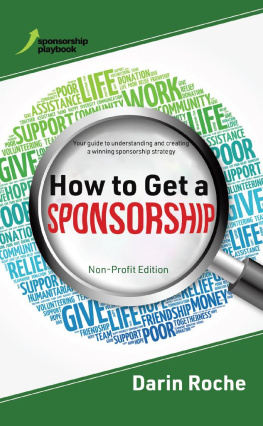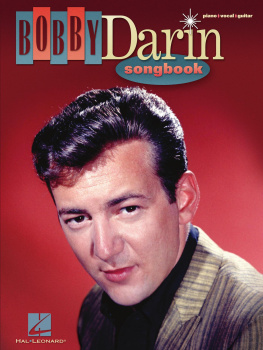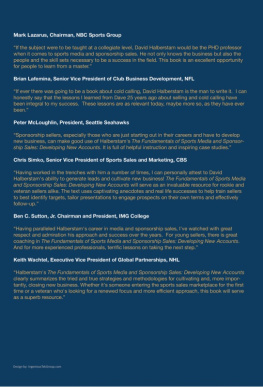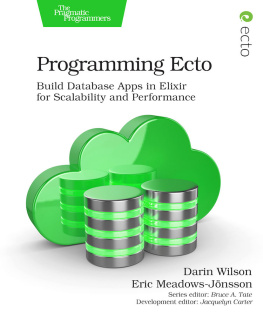How to Get a Sponsorship
Non-Profit Edition
Darin Roche
How to Get a Sponsorship
Copyright 2020 by Darin Roche
All rights reserved. No part of this publication may be reproduced, distributed, or transmitted in any form or by any means, including photocopying, recording, or other electronic or mechanical methods, without the prior written permission of the author, except in the case of brief quotations embodied in critical reviews and certain other non-commercial uses permitted by copyright law.

Tellwell Talent
www.tellwell.ca
ISBN
978-0-2288-3272-0 (Paperback)
978-0-2288-3273-7 (eBook)
Table of Contents
The sponsorship marketing industry represented more than US$65,000,000 in annual global sales in 2018. This is a staggering number. Would your organization benefit from having a sponsor as part of your fundraising goals? If so, how do you tap into that market? As a non-profit organization, you will need to step back and learn from The Sponsorship Playbook that I have created in the following pages.
I have been involved in the sponsorship marketing industry for over 18 years. As a Sponsorship Director for several organizations in the past, I have learned many ways to obtain and maintain relationships with sponsors to keep them coming back year after year on many projects. I am excited to have the opportunity to share my strategy with you to better prepare your organization for winning in the sponsorship marketing industry.
The following pages will help your organization understand the industry, design and tools required in a detailed three-phase approach to sponsorship marketing development. I will take you through the importance of fundraising with sponsors, the creation of a winning sponsorship deck and finally the strategy to implement the tools you will need to start winning in sponsorship.
As non-profit organizations can seek sponsors for many activities and events, for the remainder of the book I will refer to these as events.
Phase 1
Importance of Sponsorship Development
Traditional forms of fundraising differ from corporate sponsorship. Understanding the differences will help in the approach you take towards your organizations events that will require sponsorship.
Fundraising is the process of requesting contributions of money from individuals, businesses or charitable organizations. For a long time, typical fundraising consisted of asking for money through donation letters or going door to door asking for donations. Childrens sports teams will usually have the parents taking different product forms to work or to their family as part of a fundraising campaign. An example might be a raffle for two flights anywhere a certain airline travels. Fundraising is used mostly by non-profit organizations, but newer and unique ways of fundraising have emerged within the for-profit sector as well, for example using online raffle sites. Below is an example of a traditional form of fundraising.
A traditional fundraising method is bottle drives for your childrens sports teams, Girl Guide cookie drive, or charity auctions. Larger organizations that use similar fundraising methods include the Red Cross, Make A Wish Foundation and Unicef, to name a few. These organizations promote fundraising events each year to help reach their funding goals, which will help them stay in business and continue to spread their mes sage.
As fundraising involves a donation of money, the benefit to the funder is the opportunity to give back to the community. In some cases, the funder may be offered a donation receipt, which can be used at tax time. Consult with a taxation professional for further details.
Sponsorship is the financial support given towards an event, festival, activity, idea or person in return for equal monetary value of the sponsorship. For example, a sponsor gives $15,000 to a non-profit organization in exchange for receiving $15,000 of value in return.
Three Ways a Company Can Be a Sponsor
Cash Sponsorships
Cash sponsorships are an investment from a company that is interested in supporting your event or organization. They give you a cash investment in return for having their brand promoted at your event, with the promotion worth an equal value.
Media Sponsorships
Media sponsors are financial sponsors that secure advertising for an event, often using a matching funds model. For example:
Your organization establishes a partnership with a media company. The media company wishes to do a 50/50 advertising spend. Here is how it works. Your organization spends $2,000 in advertising. A media sponsor will put in an additional $2,000 sponsorship for advertising for a total ad spend of $4 ,000 .
Both the non-profit and the funder benefit from the ad, which will help to increase awareness and reach for both parties. In return for the new sponsorship of $2,000 that the media sponsor gave, you will provide $2,000 worth of sponsorship benefits, which we will cover in Phase 2.
In-Kind Sponsorships
In this type of sponsorship, goods or services are provided instead of cash in return for equal value. For example:
If your organization needs event insurance, you may source a sponsor in that field to work with your organization to offer event insurance at no cost to you in dollars. The value in dollars of insurance is considered in -k ind . You will then provide that value in dollars worth of sponsorship bene fits.
Sources of Revenues for an Event
For an event to be successful, multiple sources of revenue are often needed. Organizations need to understand that sponsorship funding is only one piece. I refer to this as the One-third Approach, as described below:
There are many government grants and foundation programs offered throughout the world to assist your organizations sponsorship funding activities. Each country will have its own unique way in which to offer assistance to your organiza tion.
The sale of tickets, merchandise, application fees and submission fees are examples of what makes up your organizations program revenue. It is good practice to visit the cost of these items every two years. A small bump in tickets, fees and submissions can mean more revenue to your bottom line.
The third revenue source is sponsorship, which is the financial support given towards an event, festival, activity, idea or person in return for equal monetary value of the sponsor ship.
The One-third Approach is a protocol that I have used when working with clients to help me analyze the current state of an organizations financial healthwhat I call its heartbeat. In an ideal scenario, each of the above revenue sources would represent 33.33% of your total budget for your event.
Relying too heavily on government funding and less on program and sponsorship revenue puts your activities in a position of potential failure. Since we know that government funding can be here one year and gone the next without warning, the importance of sponsorship revenue becomes your best ally for your organizations stability and success.
As a good practice, you should analyze your current budget for your activity and break down where the revenue is currently coming from. From here, you will get a snapshot of what needs attention to satisfy the One-third Approach.

One-third Approach example:
Your event budget$50 ,000
Made u p of:
Government/Foundation Funding$16,666 1/3
Program Revenue$16,666 1/3
Next page










